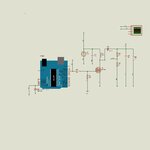Ganesan_R
Junior Member level 1
Dear Sir,
Pl. find attached the Arduino dc boost converter boost converter proteus simulation file and program.
I wanted the output to settle at 40V, but it shows variation between 48V-54V of course at switching frequency.
Of course PWM frequency is alright at 65kHz.
The relevant code is:
Any help will be deeply appreciated.
Thanks.
Yours sincerely,
R. Ganesan.
Pl. find attached the Arduino dc boost converter boost converter proteus simulation file and program.
I wanted the output to settle at 40V, but it shows variation between 48V-54V of course at switching frequency.
Of course PWM frequency is alright at 65kHz.
The relevant code is:
Code:
void loop() {
// put your main code here, to run repeatedly:
actualVoltage = analogRead(A5)*(4.9/1023)*(160/20);
if (actualVoltage>(desiredVoltage+0.5))
{
OCR2A--;
}
else if (actualVoltage<(desiredVoltage-0.5))
{
OCR2A++;
}
}Thanks.
Yours sincerely,
R. Ganesan.
Attachments
Last edited by a moderator:
